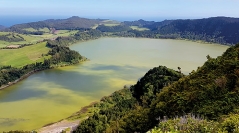

 Cryptogamie, Algologie
41 (9) - Pages 73-89
Cryptogamie, Algologie
41 (9) - Pages 73-89Cyanobacteria are diverse, complex and a unique group of microorganisms that inhabit a wide variety of environments. Contrarily to continental areas, studies on cyanobacteria in islands are scarce and need to be reinforced, since climate change impacts are expected to be harsher in islands, due to their geographical isolation and higher exposition to external influences. Here we present a review of the occurrence of cyanobacteria and cyanotoxins in inland and coastal ecosystems in the Atlantic Ocean islands. These microorganisms were reported from diverse habitats, including saline thermal lakes (Iceland), freshwater lakes, terrestrial habitats (Azores, Cuba), and marine coastal areas, either planktonic (Madeira, Canary Islands, Cape Verde) or associated to plants and corals (Brazil, Caribbean Sea). Most of cyanobacteria were reported from freshwaters but some species were found in different habitats. Species richness also varied between islands, with higher number in islands located in temperate regions, and the number of common taxa was low (1-3%). Several toxic species and different types of cyanotoxins were also reported in the Atlantic islands, which are expected to increase with climate change. Mitigation measures should be considered to avoid cyanotoxins risks to environmental and public health. This works shows the great potential of Atlantic islands for cyanobacteria taxonomic, ecological and biogeography research, but more studies are needed with emphasis on less studied islands and habitats and using novel approaches as molecular systematics tools. Furthermore, such studies are of paramount importance for environmental conservation and management strategies, especially facing climate changes.
Oceanic islands, Iceland, Azores, Cuba, biodiversity, climate change, cHABs